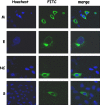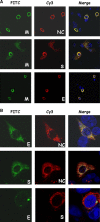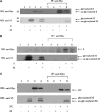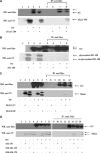Interactions between M protein and other structural proteins of severe, acute respiratory syndrome-associated coronavirus
- PMID: 18792806
- PMCID: PMC7089546
- DOI: 10.1007/s11373-008-9278-3
Interactions between M protein and other structural proteins of severe, acute respiratory syndrome-associated coronavirus
Abstract
Severe acute respiratory syndrome-associated coronavirus (SARS-CoV) structural proteins (S, E, M, and NC) localize in different subcellular positions when expressed individually. However, SARS-CoV M protein is co-localized almost entirely with S, E, or NC protein when co-expressed in the cells. On the other hand, only partial co-localization was observed when S and E, S and NC, or E and NC were co-expressed in the cells. Interactions between SARS-CoV M and other structural proteins but not interactions between S and E, S and NC, or E and NC were further demonstrated by co-immunoprecipitation assay. These results indicate that SARS-CoV M protein, similar to the M proteins of other coronaviruses, plays a pivotal role in virus assembly. The cytoplasmic C-terminus domain of SARS-CoV M protein was responsible for binding to NC protein. Multiple regions of M protein interacted with E and S proteins. A model for the interactions between SARS-CoV M protein and other structural proteins is proposed. This study helps us better understand protein-protein interactions during viral assembly of SARS-CoV.
Figures








Similar articles
-
Expression and membrane integration of SARS-CoV E protein and its interaction with M protein.Virus Genes. 2009 Jun;38(3):365-71. doi: 10.1007/s11262-009-0341-6. Epub 2009 Mar 19. Virus Genes. 2009. PMID: 19322648 Free PMC article.
-
Self-assembly of severe acute respiratory syndrome coronavirus membrane protein.J Biol Chem. 2010 Apr 23;285(17):12862-72. doi: 10.1074/jbc.M109.030270. Epub 2010 Feb 12. J Biol Chem. 2010. PMID: 20154085 Free PMC article.
-
Characterization of severe acute respiratory syndrome coronavirus membrane protein.FEBS Lett. 2006 Feb 6;580(3):968-73. doi: 10.1016/j.febslet.2006.01.026. Epub 2006 Jan 19. FEBS Lett. 2006. PMID: 16442106 Free PMC article.
-
Receptor recognition and cross-species infections of SARS coronavirus.Antiviral Res. 2013 Oct;100(1):246-54. doi: 10.1016/j.antiviral.2013.08.014. Epub 2013 Aug 29. Antiviral Res. 2013. PMID: 23994189 Free PMC article. Review.
-
SARS virus: the beginning of the unraveling of a new coronavirus.J Biomed Sci. 2003 Nov-Dec;10(6 Pt 2):664-75. doi: 10.1159/000074077. J Biomed Sci. 2003. PMID: 14631105 Free PMC article. Review.
Cited by
-
Molecular diagnosis of COVID-19 in different biologic matrix, their diagnostic validity and clinical relevance: A systematic review.Life Sci. 2020 Oct 1;258:118207. doi: 10.1016/j.lfs.2020.118207. Epub 2020 Aug 7. Life Sci. 2020. PMID: 32777301 Free PMC article.
-
Coronavirus pathogenesis.Adv Virus Res. 2011;81:85-164. doi: 10.1016/B978-0-12-385885-6.00009-2. Adv Virus Res. 2011. PMID: 22094080 Free PMC article. Review.
-
A recent origin of Orf3a from M protein across the coronavirus lineage arising by sharp divergence.Comput Struct Biotechnol J. 2020 Dec 4;18:4093-4102. doi: 10.1016/j.csbj.2020.11.047. eCollection 2020. Comput Struct Biotechnol J. 2020. PMID: 33363705 Free PMC article.
-
Novel coronavirus-like particles targeting cells lining the respiratory tract.PLoS One. 2018 Sep 5;13(9):e0203489. doi: 10.1371/journal.pone.0203489. eCollection 2018. PLoS One. 2018. PMID: 30183777 Free PMC article.
-
Comirnaty-Elicited and Convalescent Sera Recognize Different Spike Epitopes.Vaccines (Basel). 2021 Dec 1;9(12):1419. doi: 10.3390/vaccines9121419. Vaccines (Basel). 2021. PMID: 34960165 Free PMC article.
References
-
- Rota PA, Oberste MS, Monroe SS, Nix WA, Campagnoli R, Icenogle JP, Penaranda S, Bankamp B, Maher K, Chen MH, Tong S, Tamin A, Lowe L, Frace M, DeRisi JL, Chen Q, Wang D, Erdman DD, Peret TC, Burns C, Ksiazek TG, Rollin PE, Sanchez A, Liffick S, Holloway B, Limor J, McCaustland K, Olsen-Rasmussen M, Fouchier R, Gunther S, Osterhaus AD, Drosten C, Pallansch MA, Anderson LJ, Bellini WJ. Characterization of a novel coronavirus associated with severe acute respiratory syndrome. Science. 2003;300:1394–1399. doi: 10.1126/science.1085952. - DOI - PubMed
-
- Kuiken T, Fouchier RA, Schutten M, Rimmelzwaan GF, van Amerongen G, van Riel D, Laman JD, de Jong T, van Doornum G, Lim W, Ling AE, Chan PK, Tam JS, Zambon MC, Gopal R, Drosten C, van der Werf S, Escriou N, Manuguerra JC, Stohr K, Peiris JS, Osterhaus AD. Newly discovered coronavirus as the primary cause of severe acute respiratory syndrome. Lancet. 2003;362:263–270. doi: 10.1016/S0140-6736(03)13967-0. - DOI - PMC - PubMed
-
- Gu J, Gong E, Zhang B, Zheng J, Gao Z, Zhong Y, Zou W, Zhan J, Wang S, Xie Z, Zhuang H, Wu B, Zhong H, Shao H, Fang W, Gao D, Pei F, Li X, He Z, Xu D, Shi X, Anderson VM, Leong AS. Multiple organ infection and the pathogenesis of SARS. J Exp Med. 2005;202:415–424. doi: 10.1084/jem.20050828. - DOI - PMC - PubMed
Publication types
MeSH terms
Substances
LinkOut - more resources
Full Text Sources
Miscellaneous
